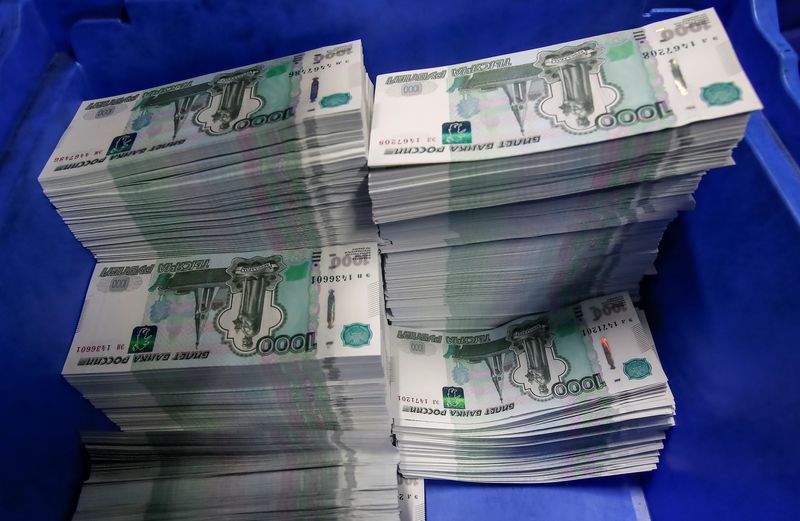LONDON (Reuters) -Russia’s rouble fell sharply in thin trading on Monday to a fresh record low, with local markets closed for trading until at least Wednesday.
The rouble has lost nearly 50% of its value against the greenback since the start of the year, with losses sharply accelerating since Russia invaded Ukraine on Feb. 24, a move that sparked sweeping sanctions from various governments across the world.
The rouble bids were indicated as far as 150 to the dollar after closing at 121.037 on Friday, according to Refinitiv data. On the EBS trading platform, the rouble weakened as far as 160 to the dollar, or more than 22%, and was recently traded at 145, down 14.5% on the day.
Bid/ask spreads were between 7 and 15 cents, pointing to an increasingly illiquid market.
Trading on the MOEX Moscow exchange is scheduled to be closed until Wednesday for a bank holiday.
The curbs on Russia, its lenders, corporates and key individuals, as well as counter measures from Moscow, have cut Russian assets increasingly out of global financial markets and have made it hard for investors to trade any securities.
“The future doesn’t look bright for the Russian rouble at all,” said Ipek Ozkardeskaya, senior analyst at Swissquote.
“The combination of western sanctions, the rising risk of default and the incentive to divest from rouble-denominated assets will likely further weigh on the currency.”
Stocks last traded on Feb. 25 on Moscow’s bourse. An ETF of Russian and Russia-exposed companies traded in the United States was halted on Friday after dropping nearly 80% year-to-date.
Five-year credit default swaps in Russia – reflecting the cost to insure exposure to the country’s sovereign debt – soared to a record 2,757 basis points compared to 1,725 basis points on Friday, data from IHS Markit showed.
Trades on Russia’s sovereign dollar- and euro-denominated debt have all but ground to a halt, with some issues bid at around 20 cents in the dollar or euro.
“With Russian prices on the euro bond somewhere around 20, this is going to go on for a long, long time, and nobody wants to be associated with (the rouble),” said Gabriel Sterne, head of global EM research at Oxford Economics.
“Just sell it and take a loss. You have to interpret the price movements as: there’s almost infinite supply and very little demand for these assets at the moment. It’s now just a matter of an orderly disposal of Russian assets.”
Russia calls its actions in Ukraine a “special operation.”
Rouble implied volatility gauges – a measure of demand for options on the currency rising or falling against the dollar – have stayed near record highs hit last week, with the one-week gauge above 84% and the one-month one above 94%.
The rouble’s collapse has also hit trading volumes. Turnover on the Russian currency on EBS fell more than 80% on Friday compared to the end of February.
(Reporting by Karin Strohecker and Rodrigo Campos; Additional reporting by Bansari Mayur Kamdar, Saikat Chatterjee and Anisha Sircar; Editing by Chizu Nomiyama and Andrea Ricci)

























